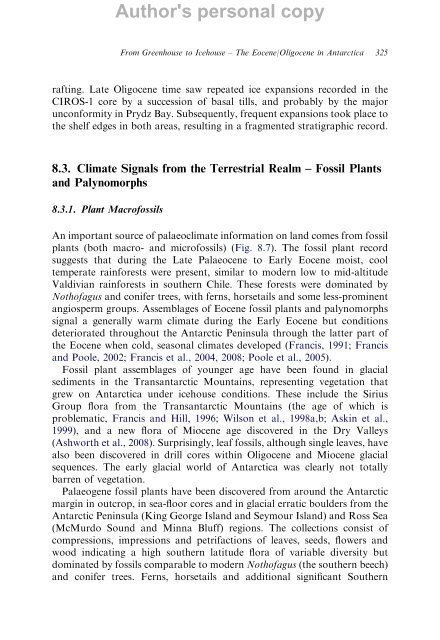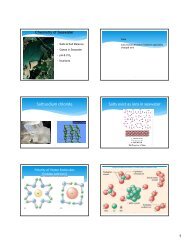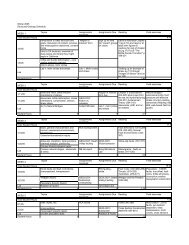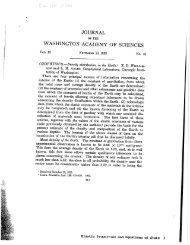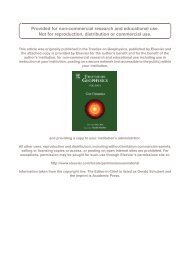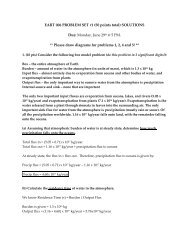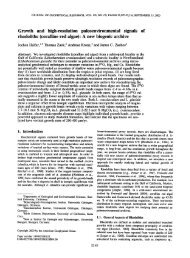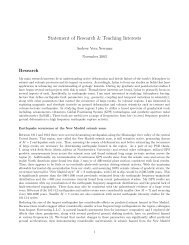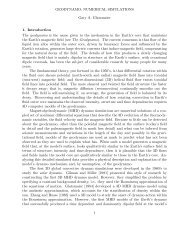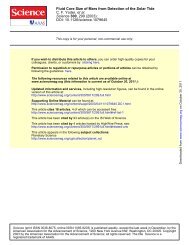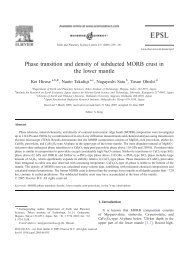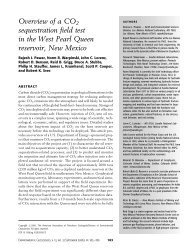From Greenhouse to Icehouse – The Eocene/Oligocene - UMass ...
From Greenhouse to Icehouse – The Eocene/Oligocene - UMass ...
From Greenhouse to Icehouse – The Eocene/Oligocene - UMass ...
You also want an ePaper? Increase the reach of your titles
YUMPU automatically turns print PDFs into web optimized ePapers that Google loves.
afting. Late <strong>Oligocene</strong> time saw repeated ice expansions recorded in the<br />
CIROS-1 core by a succession of basal tills, and probably by the major<br />
unconformity in Prydz Bay. Subsequently, frequent expansions <strong>to</strong>ok place <strong>to</strong><br />
the shelf edges in both areas, resulting in a fragmented stratigraphic record.<br />
8.3. Climate Signals from the Terrestrial Realm <strong>–</strong> Fossil Plants<br />
and Palynomorphs<br />
8.3.1. Plant Macrofossils<br />
Author's personal copy<br />
<strong>From</strong> <strong>Greenhouse</strong> <strong>to</strong> <strong>Icehouse</strong> <strong>–</strong> <strong>The</strong> <strong>Eocene</strong>/<strong>Oligocene</strong> in Antarctica 325<br />
An important source of palaeoclimate information on land comes from fossil<br />
plants (both macro- and microfossils) (Fig. 8.7). <strong>The</strong> fossil plant record<br />
suggests that during the Late Palaeocene <strong>to</strong> Early <strong>Eocene</strong> moist, cool<br />
temperate rainforests were present, similar <strong>to</strong> modern low <strong>to</strong> mid-altitude<br />
Valdivian rainforests in southern Chile. <strong>The</strong>se forests were dominated by<br />
Nothofagus and conifer trees, with ferns, horsetails and some less-prominent<br />
angiosperm groups. Assemblages of <strong>Eocene</strong> fossil plants and palynomorphs<br />
signal a generally warm climate during the Early <strong>Eocene</strong> but conditions<br />
deteriorated throughout the Antarctic Peninsula through the latter part of<br />
the <strong>Eocene</strong> when cold, seasonal climates developed (Francis, 1991; Francis<br />
and Poole, 2002; Francis et al., 2004, 2008; Poole et al., 2005).<br />
Fossil plant assemblages of younger age have been found in glacial<br />
sediments in the Transantarctic Mountains, representing vegetation that<br />
grew on Antarctica under icehouse conditions. <strong>The</strong>se include the Sirius<br />
Group flora from the Transantarctic Mountains (the age of which is<br />
problematic, Francis and Hill, 1996; Wilson et al., 1998a,b; Askin et al.,<br />
1999), and a new flora of Miocene age discovered in the Dry Valleys<br />
(Ashworth et al., 2008). Surprisingly, leaf fossils, although single leaves, have<br />
also been discovered in drill cores within <strong>Oligocene</strong> and Miocene glacial<br />
sequences. <strong>The</strong> early glacial world of Antarctica was clearly not <strong>to</strong>tally<br />
barren of vegetation.<br />
Palaeogene fossil plants have been discovered from around the Antarctic<br />
margin in outcrop, in sea-floor cores and in glacial erratic boulders from the<br />
Antarctic Peninsula (King George Island and Seymour Island) and Ross Sea<br />
(McMurdo Sound and Minna Bluff) regions. <strong>The</strong> collections consist of<br />
compressions, impressions and petrifactions of leaves, seeds, flowers and<br />
wood indicating a high southern latitude flora of variable diversity but<br />
dominated by fossils comparable <strong>to</strong> modern Nothofagus (the southern beech)<br />
and conifer trees. Ferns, horsetails and additional significant Southern


